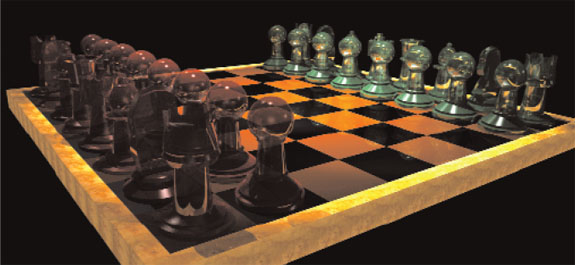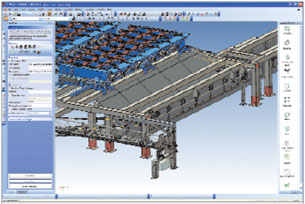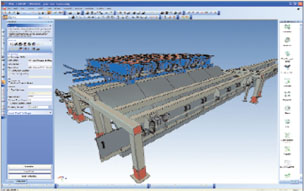Latest News
February 1, 2008
By Al Dean
 New support for caustics in IronCAD V10 means that when light passes through and is refracted andreflected by transparent objects, the lighting effect surrounding the objects appears much more real. |
IronCAD has been on the market for almost 10 years and has always been impressive in terms of usability. The user interaction and experience has always been very dynamic. Models are built by pulling and pushing geometry, rather than the sketch-feature workflow in many of its competitors. Everything is done in a single file, with parts and assemblies interacting. Sound familiar? Yup, with SpaceClaim grabbing the headlines, the fact is that much of that system’s power has been built before — in IronCAD and others. What has changed is the interface — so let’s see how IronCAD has adapted to a new entrant into its market space.
For those already familiar with the system, the immediately obvious update is the interface. While the developers haven’t adopted the Ribbon and Tab interface that’s now common in Office products, the UI does pave the way for a full Vista-style update with the next release. Alongside core UI infrastructure updates, the Catalog (which contains the modeling features, operations, and parts libraries) to the right of the screen has been updated with higher-quality representations of the contents — there’s also greater use of color to differentiate between adding or cutting features. You’ll find more information on tool tips and dropdown menus so you can customize the menus and toolbars to fit your requirements. This information is then stored in an XML file that can be distributed (and it can also be locked to maintain corporate standards).
 The new Support for HDR (high dynamic range) images, which provides much more realistic and richlighting conditions during rendering, means that realism is eminently possible, without too much effort. |
The display engine has been swapped out from the existing in-house technology to take advantage of the HOOPS 3D libraries from Tech Soft 3D, resulting in performance improvements in terms of frame rate (using a tessellated version of the geometry when you’re manipulating the geometry). The addition of HOOPS 3D also gives IronCAD the ability to take advantage of the latest graphics cards and DirectX (critical for moving forward to Vista). The Visual Load option uses a multithreaded approach when loading data that initially brings in the HOOPS stream file data on one processor and allows it to manipulate the view, while the other processor will load the full description.
The new Property Manager is a context-sensitive window that presents all of the commands, options, and parameters that relate to your current task or selection. If you’re working with an assembly, it presents the display options. If you’re working on a feature, it presents dimensional variables. If you’re creating or editing sketch geometry, it provides you with controls over the properties of the entities, and assists with creation and editing.
For existing IronCAD users, this information was typically distributed across several dialogs and areas of the system – so the consolidation work will make your workflows more efficient. It is interesting that because of the history handling within IronCAD, you can use the same commands to edit multiple features at once; all possible because of the sizing-box methodology.
Modeling Updates
IronCAD V10 contains improvements to the creation of sketch geometry within a 3D model. The new SmartConstraints allow you to snap to existing 3D geometry within parts or assemblies without having to project the geometry onto each sketch. There is greater feedback on Constraint status using color to indicate whether a sketch is under (white), fully (green), or over (red) constrained. Again, the new Quick Access Property Browser allows you to create and edit constraints very quickly, as all of the options or possible constraints are presented according to your selection.
There’s also been development on IronCAD’s 3D curve and surfacing functionality. This has been a core concentration for the last few releases and with aesthetic quality becoming more a requirement than option — in every area of engineering — these types of tools will be used much more frequently.
It’s now possible to display curve tangency and curvature for both 2D and 3D curves and gain a better understanding of how those curves are going to replicate any problems when used as the basis for surfaces. And in terms of editing curves, developers have improved the direct manipulation of curve entities, with handle support added to control magnitude (or a tangency vector control) settings.
In terms of assembly modeling, the big headline item for this release has to be the introduction of dynamic mechanism simulation, which has been implemented with full collision detection — the collision-finding tools can work on specific parts (if you have an inkling where the problem might lie) or all parts in an assembly. The system can stop at collisions and will, of course, highlight intersecting faces. While this is useful for the inspection of a mechanism, its real value is found when you have a basic mechanism but want to design additional components. This ability allows you to find the reach or movement of a mechanism and have the system store that position so you can design to that accurate position.
 Alongside core UI updates, version 10’s Catalog (with features, operations, and parts libraries) to theright of the screen has been updated with higher-quality representations of the contents. |
2D Updates
View creation time has been reduced with the introduction of Quick Views, which uses the HOOPS facet data to generate drawing views much more efficiently. These can be mixed and matched within a single drawing sheet, so you can make the best use of the accuracy of the data you need. And there are now filters to edit the annotation data transferred from the 3D model to the 2D drawing — whether that’s hole data, sheet metal features and such, you can control what’s brought across.
On the subject of drafting, this release offers three core updates to assist you with creating those all-important drawings in the style you want — rather than having the system prescribe how it should be done. For example, there’s been an update to BOM creation so you can sort and format your tables the way you require. And you can now create a hole table for hole callouts, making annotation of such features much more efficient. Finally, there’s been support added for PDF, using the Adobe libraries. While IronCAD has supported the output of drawing sheets as 2D PDFs in the past, this release includes new support added for 3D PDF.
 IronCAD V10 makes greater use of color to differentiate between adding or cutting features. You’ll findmore information on tool tips and dropdown menus to customize the menus and toolbars. |
Visualization
When I first looked at IronCAD — too many years ago to even think about — one thing that impressed me at the time was the ease of use of the rendering tools. That’s still true in many respects, but as with all things technological, these things move on and the rendering capabilities within IronCAD fell behind the state of the art. No longer.
New Rendering tools in Version 10 provide support for the full gamut of ray-tracing techniques and technologies, which in today’s world includes caustics, soft shadows, glow, emission, and depth of field as well as radiosity and global illumination. There are new material shaders, but these are again implemented using the same, easy-to-use catalog-based drag-and-drop workflow.
For those users crunching complex models and materials or creating very high-resolution images, the good news is that the rendering tools are now multithreaded, so if you’re running multiprocessor or multicore machines, it should be a lot more efficient. There are also additional image export formats and updated codec support for animation export.
Drag and Drop
Alongside the major updates we’ve covered here, there’s a lot more under the hood for those already using IronCAD. While I’m a little disappointed that the team has chosen an interim stepping stone before moving to the ribbon-style toolbar that’s now increasingly common in all areas of software, the updates to this release’s UI, combined with the greater use of the Property Manager, will make interaction with the finer points of features and operations easier.
The new assembly simulation tools are going to be manna from heaven for many of the users out there looking to build mechanisms and machinery. Version 10 is ideally suited to this task, particularly if you’re working with modular products and subsystems — IronCAD’s drag-and drop approach works wonders in that environment.
Do It Your Way
So, what of the system as a whole? While IronCAD came on to the market at the same time or shortly after the explosion of the midrange market with SolidWorks (backed by Dassault Systemes), Mechanical Desktop from Autodesk, Solid Edge, et al, and missed the opportunity for gaining more traction, the concept has always been valid. That is, to enable design creation and modification using drag-and-drop, dynamic manipulation of geometry.
Does that sound familiar? Of course it does, and will increasingly sound so. The market is moving toward this type of technology, with similar features added into SolidWorks, CATIA, Solid Edge, NX, and the others. And of course, there’s SpaceClaim. There’s also PTC’s recent acquisition of CoCreate, being positioned as adding direct modeling to the fold. Dynamic and direct manipulation of geometry is going to grow, with some vendors faster than others, some as a reaction to competitors’ moves, some as a desire to improve ease of use.
All this places IronCAD in a strong position because it was built from the ground up to work just this way and benefits from at least 10 years of development work. If you’re thinking that direct modeling might be for you, try a system that’s been doing it for years.
What’s also interesting is that IronCAD has a lot of the tools that other systems have, such as parametric design, a history tree and such, so you can work with it however you wish. And did I mention it has great translation tools?
In short, many are working on dynamic modeling on top of their existing capabilities, while others are starting from scratch. IronCAD has a healthy, robust, and growing set of tools that can do the job your way.
More Info:
HOOPS 3D
Tech Soft 3D
Berkeley,CA
hoops3d.com
IronCAD
Atlanta,GA
ironcad.com
Al Dean is technology editor at MCAD Magazine, a UK product development and manufacturing technology journal (mcadonline.com) and is editor of Prototype magazine (prototypemagazine.com). You can send comments about this article to DE-[email protected].
Subscribe to our FREE magazine, FREE email newsletters or both!
Latest News
About the Author
DE’s editors contribute news and new product announcements to Digital Engineering.
Press releases may be sent to them via [email protected].






